Bobby Amanullah Shamroze Khan, a relic of the surviving Cameleer generation in Australia
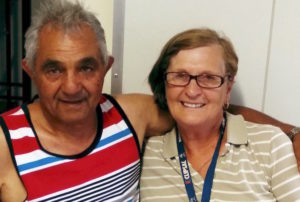
Bobby, Amanullah Shamroze Khan with his wife Janet
By Neena Badhwar
Everyone calls him Bobby but his real name is Amanullah Shamroze Khan, one of the last surviving members of the Afghan cameleers that roamed the Australian countryside taking stores from one remote area to the other.
Meeting Bobby was by chance when we went looking for the famous mosque. We were told that the caretaker was away on a holiday. “Come another time,” the lady on the contact list replied.
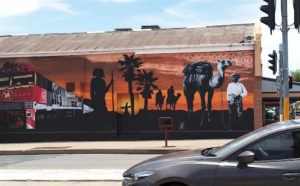
Mural of Dervish Bejah, great uncle of Bobby, the Afghan cameleer who roamed the outback with his camels to deliver supplies, seen also is The Ghan named after the Afghan cameleers
Seeing the cameleer mural of Dervish Bejah near our hotel in Broken Hill and again in White Cliffs, another mural of the cameleers, fuelled our wont to get in touch with this missing man, the last of the cameleers.
Travelling in the outback, we arrive at Menindee Lakes Caravan Park. Guess who do we meet at the counter.
Bobby and his wife Janet, of course.
It was sheer serendipity. We could not believe our luck when Bobby innocently asked where we were from.
He is indeed one of the last of the surviving Afghan cameleers we were looking for, the very cameleers who fed early Australians settled in this then vast unfriendly land.
From the 1860s to the 1930s, an estimated 20,000 camels and more than 2000 cameleers – men skilled in handling them – were shipped to Australia from Afghanistan and Pakistan.
One cannot imagine the life in early Australia as the interior of Australia had no roads or vehicles like we have today, just the hard, rugged bush. Early Australia was settled on these camels’ backs as only they could withstand it without food and water for days at a stretch, with their handlers walking besides them supplying food and supplies to gold mines across the vast outback.
Bobby was only seventeen and Janet fourteen and a half when they eloped, marrying later when Janet turned 21. Bobby’s dad, Shamroze Khan, was from Peshawar, India, now in Pakistan. His mother was an Indian named Miriam Faizullah whose father was from Uttuck.
Bobby’s grandfather and father worked as cameleers and also as camel dealers who operated between Queensland and Broken Hill and around the Menindee area. They were around 150 in number but by the time Bobby was born in 1940, camel runs had stopped.
Bobby was the youngest of the three siblings and born late when his father was in his seventies. Now at the age of 77, Bobby is the caretaker of the only Afghan mosque in Broken Hill, the oldest and first in Australia, having been built in 1889. There is another old Mosque in Perth called the Mohameddan mosque built by the Afghans in 1905.
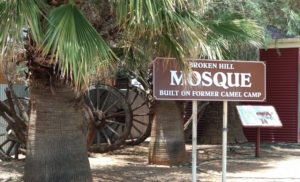
First mosque in Australia that was built by the Afghan cameleers in 1889
Bobby met Janet in Naracote near Mt. Gambier where he worked as a shearer. They have three children, seven grand children and four great grand children.
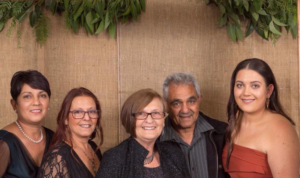
The Khans, Bobby and Janet Amanullah with his family members
Bobby’s mother, Miriam Faizullah had married Bobby’s dad when he was more than 60 years old. Miriam had an Indian father and Irish mother.
Miriam was very young when she married and separated from her husband early in the marriage when Bobby was only four-years-old.
Bobby remembers that once he ran from home in Broken Hill to Adelaide, boarding a train at the age of nine as he went looking for his mum.
“I was hiding in the train and was caught by the police. The story came out in the local paper of me being lost.
“Mum always used to send me back to my dad who died when I was still very young in 1952. My grandfather died in 1962 when I was twenty.
“They did not teach me our language or even our religion,” he says. “All I know is this,” touching his heart with his hand and bowing a little. “I learnt this by watching granddad.”
“I remember when he died and how he was buried. They opened the coffin and tilted his head towards the west (towards Mecca) and closed the lid and lowered it into the ground as they threw dirt on the coffin.
“My grandfather used to carry supplies to Queensland and bring wool back on camels. That’s all I remember. As I was kept in boys’ homes, I went to churches all around, not knowing my own religion. I respect Allah and so also the other religions as God is one,” Bobby said.
When asked, if he would ever want to visit his place back home in Peshawar, “Someone offered me to take me there,” but he enquires, he said, “Isn’t there where there is too much trouble?”
What about his heritage, that he belonged to the famous cameleers!
He said: “Australia wouldn’t be what it is today but for them as they supplied food to far off places. It was a very hard life for them. At times the cameleers were away for months ”“ three to four months at a time – and women looked after the children. Where did they have time to pass on their culture or religion to their future generation.
“Since these men married local women who also did not know much about the religion or our culture or even the language, we have not learnt our religious practices,” he said.
Bobby’s father had a green velvet coat from India with embossed gold thread embroidery which he remembers him wearing on special occasions. It was sent to the Powerhouse Museum in Sydney to be restored and was later brought back to Broken Hill Museum where it is displayed in a glass case.
“They said it was an important piece of the history and spent $4,000 in restoring it,” said Bobby.
The newly arrived Afghani community visit the mosque when they pass through Broken Hill and need to pray. It is now an established historical landmark.
“They ask me questions about our religion. Since I was born here and went to Church, I simply believe in all religions. I do respect when they come to pray.
“I have been invited by the Turkish Council of Australia for a symposium in Sydney and was interviewed by the local radio there. The Government has given the Broken Hill Heritage Council a grant of $260,000 to maintain the mosque and renovate it as they think it is an important building from an historical point of view.
“Now I realise how important my family history is and my heritage as well. When I was young I did not realise the importance of it all. But now I feel I should collect everything I have and preserve it. One girl came and donated a picture of her great grandfather who was also a cameleer. There is my father’s picture in the mosque and few other artefacts,” he said.
The big mural opposite Ibis hotel in Broken Hill is of Dervish Bejah with a camel, happened to be the great uncle of Bobby.
There are not many left from the cameleers’ generation, except Bobby and a couple more – an uncle and an aunty from Bobby’s grandma side. Most of them were named Zaidullah and Amanullah.
Bobby has appeared in some documentaries and has been interviewed by television channels and radios.
Having just met him and learnt his story, I cannot digest when on a boat cruise around Menindee Lake, the operator mentions that the first terrorist attack in Australia was 100 years ago, in 1915, when two Afghans killed four people due to Britain’s involvement in Turkey.
Bobby’s father and uncle had refused the burial services of the two who were killed by the police eventually, when their bodies were brought to the mosque. The cameleers showed their allegiance to Australia, like they had for the last 80 years, and the men were eventually buried in an unmarked grave.
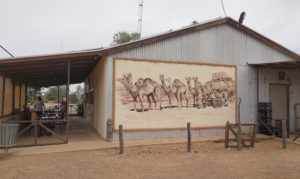
Mural of Afghan Cameleers in the opal town White Cliffs
The contribution to Australia by the Afghan cameleers can never be overlooked. They transported material for the construction of rail link between Adelaide and Darwin. Famous explorers Burke and Willis used camels and the camel drivers for their arduous expedition through Aussie inland. Next time you are in Broken Hill, do visit the mosque and learn how cameleers contributed to the building of Australia that we live in today.


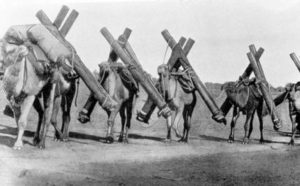
And notice the murals across these towns of cameleers, the sacrifices they made, the Afghans after whom the famous Ghan Rail gets its name that runs from Adelaide to Darwin.
Short URL: https://indiandownunder.com.au/?p=11263
